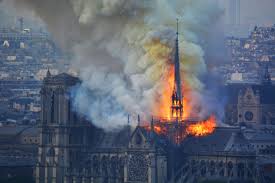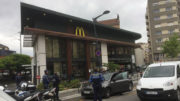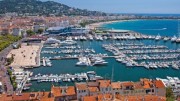I believe that few will disagree with me when I say that the Notre Dame fire is a human and cultural tragedy. Much of the structure of the roof and the spire, which was a 19th century addition, has gone but thankfully much of the stonework still stands and rescuers made heroic efforts to rescue the artistic treasures contained within the cathedral. I felt a similar sense of shock and loss as I felt when York Minster was similarly afflicted by fire back in 1984. In that incident an enquiry into the fire found that it was 80% certain that a lightning strike coupled with the extremely dry conditions at the time both caused and assisted the spread of the fire respectively. York Minister was rebuilt and restored at a cost of millions of pounds and thousands of hours of work by skilled and dedicated craftsmen. It is to be hoped that Notre Dame is restored in a similarly respectful and skilled way and as in the case of York Minister, additional fire protection measures are installed during the reconstruction.
There is a lot of speculation online about the cause of the fire with many pointing the finger at France’s Muslims, many of whom seem to hate the society that they live in and the historically Christian basis that French society was built on. Whilst I grant that there have been a large number of attacks on churches and one murderous attack on a Catholic Priest by Muslims, it is more than possible that the Notre Dame fire may not be one of those Islamic attacks. Despite the cathedral being the subject of previous Islamic terror plots there is the strong possibility that the main culprit for the fire may not be from this quarter. I may be wrong of course, but reading into the history of the building and the various restorations of it, lead me to believe that this fire at least (although maybe not others) is the result of cock up rather than Islamic conspiracy.
Unlike in the United Kingdom, the French seem to have been enormously parsimonious about the preservation of their built heritage and maybe much more lackadaisical in how restorations are managed. I have discovered that the cathedral, which is owned by the French government, was only funded by that government to the tune of £1.7M per year. This is a tiny amount when compared to the general running costs and the sheer scale of repairing the centuries of neglect and damage that Notre Dame has suffered throughout history. It was damaged during the Revolution, damaged due to mobs, by having its bells melted down to make cannons, by pollution and by neglect.
The French government has not done all it could do to preserve this majestic monument to French civilisation and history. £1.7M does not go very far when it comes to hiring and paying the sort of skilled craftsmen who are absolutely essential to maintaining and preserving places like Notre Dame. For comparison a similar building, Westminster Abbey in London, costs a minimum of £10M a year to administer and to undertake running repairs to the building. The cost of a major restoration, something that Notre Dame was badly in need of, would be far in excess of that due to the previous neglect that the building had suffered. It is my belief at this stage, pending further credible evidence to the contrary, that this fire is a French government cock up.
The French government does not seem to have put nearly enough money or effort or dedication into preserving this monument to French heritage. The building needed a proper top to bottom restoration which would have required the building to be closed to both worshippers and visitors for probably years whilst this work went on. Some of the work was plainly urgent and included shoring up the later additions to the building such as the spire and restoring the decorative stonework, some of which is said to have been melted down to mere nubs of rock by both weather and pollution. A large portion of the building was at the time of the recent fire covered in scaffolding which suggests some high level building work was going on. I’ve seen enough building sites to know that these places are hazardous, not just to unwary visitors, but they also pose fire risks due to flammable material storage on the job site and also the great many temporary electrical connections that need to be made to power various tools. It only takes one spark from a short circuit in a temporary junction box or an electrical item not shut down safely, for buildings erected before modern fire safety regulations, to go up in smoke. Fire safety measures are important for all buildings but they are even more necessary in historic buildings and especially where restoration is going on. For example: We know now that having an unobstructed open roof space without firebreaks is a disaster waiting to happen, which is why party walls in British lofts have to withstand a house fire to stop the fire spreading to neighbouring properties. Old cathedrals on the other hand often have large expanses of roof space above the vaulted roofs along with fire can spread extremely rapidly.
It is my belief, having read a little on the background of the cathedral along with the fact that the French state is notoriously bureaucratic and may have tried to do the job of restoration ‘on the cheap’, that these factors may well have contributed greatly to the outbreak and the spread of this fire. Although there has been much speculation that this fire could be the result of an Islamist attack, at present all the evidence I’ve seen, all the evidence that is credible that is, points to bad restoration management, bad work site practises, restoration cost concerns and a failure by the French government to prioritise its built heritage.
I’m pleased to see that much has been saved of Notre Dame and its treasures and the building is likely to be restored. I’m also pleased to see that many wealthy people have stepped forward to pledge money to fund the restoration. However it would have been better in my view if these wealthy individuals had stumped up the cash before this fire occurred and paid for a sensitive, skilled and most importantly safe restoration.





